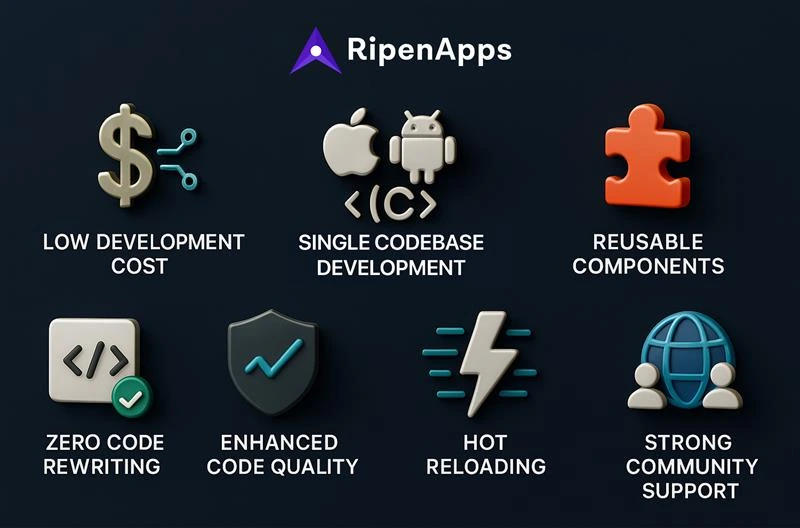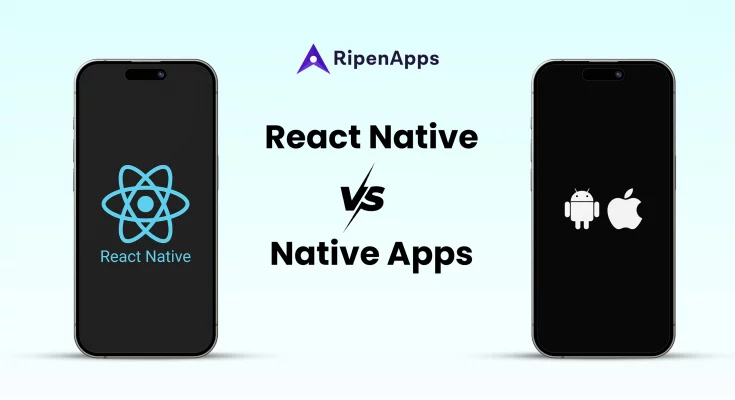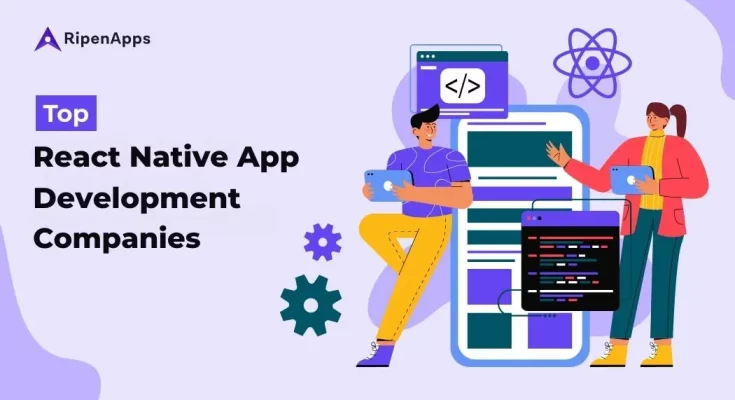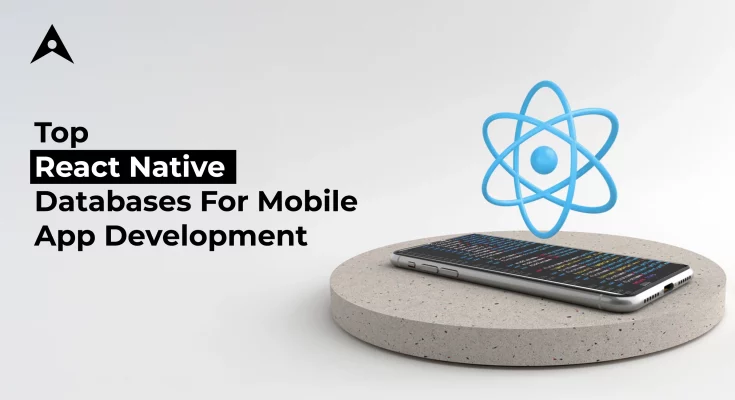In today’s digital era, businesses are racing to achieve success through high-performance mobile apps that captivate users, save development costs, and scale properly. Choosing to develop React Native app is an informed decision because this cross-platform app development framework has been a game-changer for businesses.
Developed by Facebook and used by giants like Instagram, Shopify, and Walmart, React Native has become the go-to framework for businesses to meet user demands & achieve success. But building a React Native app isn’t just about writing code. It involves more steps which should be followed properly.
In this blog, we will tell you about every necessary step to develop React Native app. From the need for using this framework to a step-by-step process, this guide will provide you with the necessary information to start your app development journey. So, let’s get started:
Table of Contents
What is React Native?
React Native, a cross-platform app development framework, works on JavaScript. Facebook (now Meta) launched this framework in 2015 to streamline app development for various platforms. It allows developers to create natively rendered mobile applications that run on iOS and Android platforms.
It will enable building applications using a single codebase, streamlining app development for multiple platforms. Businesses choose React Native for mobile app development because Facebook and Instagram are one of the most popular apps developed using React Native. This framework saves a lot of time and money by allowing developers to build mobile apps using a single codebase.
Why You Should Develop React Native App?

Now that you have already understood what is React Native, it’s time to understand the benefits of React Native app development. Looking at these advantages is important to learn why businesses should choose this framework to develop React Native app. Here’s why React Native plays an important role in building mobile apps:
1. Low Development Cost
One of the major advantages of React Native is providing cost-saving mobile app development for businesses. Startups sometimes face budget issues, and they try to spend as little money as they can. React Native didn’t increase their tension because it allows the use of a single codebase.
When you build separate apps for Android and iOS, you need to have separate resources for both platforms. On the other hand, developing a React Native app requires a single team and fewer resources. This approach saves time and money. In addition to this, it can reuse code and components, reducing the extra efforts. React Native app development cost is also pocket-friendly as compared to native app development.
2. App Development Using Single Codebase
Developers write different code for Android and iOS while building native apps. But when you develop React Native app, the library helps in the development of apps that run on both Android and iOS. React Native is based on a single codebase, allowing developers to write the code only once and run on Android and iOS. So, React Native app development companies can develop the applications with high speed and minimum efforts.
3. Reusable Components
Developers used to leverage WebView components while developing cross-platform mobile apps. But now, React Native has made it possible to use ‘native components’ to develop react native app. These components provide native-like performance to the apps.
Additionally, React Native has the ability to use Android and iOS components. This quality makes it possible for businesses to attain a platform-wise look and feel. Due to this unique approach, you can develop react native app with an agile, web-based approach. This approach leads businesses to apps that have a look, feel, speed, and necessary functionalities.
4. Zero Code Rewriting
React Native app development tools streamline building mobile applications. This framework’s library is one of the most important tools, and it allows React Native app development companies to include the native components while developing the mobile app. This approach allows developers to develop a React Native app without writing the code from scratch. Due to this advantage, developers can switch the existing process to the React Native library without extra efforts.
5. Enhanced Code Quality
When you develop React Native app, you only need to put in reduced coding efforts. By having a single codebase for various platforms, React Native app development can be helpful for developers. It can reduce the scope for bugs and faulty code, streamlining the development process.
With the improved code quality, the testing efforts can also be reduced, which makes the whole mobile app development process faster. This is one of the benefits why businesses choosing React Native application development.
6. Hot Reloading
Hot reloading is a useful benefit of React Native. When people wonder is React Native good for mobile app development? The hot reloading feature shows why this cross-platform app development framework should be chosen to develop mobile apps. This feature speeds up the development process and enables businesses to fix bugs, add features, and adjust UI elements in real time. Hot reloading allows developers to see changes immediately after making them. Along with development, hot reloading also streamlines the maintenance and updates.
7. Strong Community Support
React Native is one of the top cross-platform app development frameworks. That’s why it has strong community support. This strong community support can help you easily find resources, tutorials, and libraries to solve any issues. With the expert support, you can understand how to develop React Native app that thrives in this competitive landscape. In addition to this, the community shares React Native best practices. It helps to stay updated with the latest advancements and React Native app development trends.
Steps To Develop React Native App
After understanding the need to use React Native for developing your dream app, you need to understand the steps to develop React Native app. These steps should be followed properly to develop a cutting-edge and top-performing mobile application. Here are the important steps:
Step 1: Set Up The Development Environment
- Install Node.js and npm: You should use Node.js and npm while starting to develop React Native app. These are one of the important technologies to run JavaScript on the server and manage dependencies.
- Install React Native CLI: It’s important to install React Native command line interface (CLI) for effectively developing and managing your projects with this tool.
- Prefer JDK: Java Development Kit (JDK) is a popular tool that helps in developing Android apps because Java is essential to build Android apps through React Native.
- Install Xcode or Android Studio: Install the Android Studio software for Android and Xcode for iOS apps. These IDEs can test your application effectively without the need for emulators and tools.
These technologies and IDEs should be installed to start a seamless process. You can hire dedicated mobile app developers to help you streamline every single step.
Step 2: Plan The App Structure & Features
Before diving deep into coding, take time to strategize the functionality and layout. You should determine what problem your app solves, some key features (login, profile, feed, chat, etc.), navigation flow (how users move), and backend or API requirements. Creating basic wireframes and mock-ups can help you visualize the UI/UX of your dream app. You need to create new react native project to start seamless development.
Step 3: Build The User Interface
React Native has a wide range of built-in components like View, Text, ScrollView, and TouchableOpacity, which help build a native-style UI. You can create custom components and organize them into proper reusable modules. Here are popular styling methods:
- StyleSheet.create()
- CSS-in-JS libraries like Styled Components
- Utility-first libraries like Tailwind CSS for React Native
These methods should be followed properly to make your design come to life without any hard work. This is also an important step to develop React Native app with a smooth user interface.
Read More: Top React Native Components for Stunning And Functional App Development
Step 4: Implement Navigation
Navigation is the most important thing for a multiscreen app. In React Native, you can use the easy and popular library, React Navigation. You can install this popular and unique library by using:
“npm install @react-navigation/native”
Apart from this, you can also choose:
- Stack Navigation (for sequential screens like Login, Home)
- Tab Navigation (for bottom navigation)
- Drawer Navigation (for side menus)
Step 5: Connect To A Backend or Database
It’s important to make your app dynamic to thrive in the competitive market. When you create React Native app, it’s important to connect to a backend or React Native Databases. It can be done in many ways, and these are:
- Use fetch or axios to consume REST APIs or GraphQL.
- You can utilize Firebase for real-time databases, authentication, and push notifications.
- For local storage, consider using AsyncStorage or MMKV.
When building a large-scale application, you should implement state management using Context API, Redux, or Zustland.
Step 6: Add Core App Features
After connecting to a backend or database, you need to add the core app features and start development at a high pace. Some common app features are user authentication, push notifications, file uploads, geolocation, in-app payments, and chat & messaging. React Native has a rich plugin ecosystem, which helps in integrating features in your mobile application.
Step 7: Test Your Application
When you add features to your mobile app, it means you have completed the development. Now, the second-to-last step is testing your react native app. If you are building an MVP using React Native, then you should follow best practices for MVP testing. App testing helps you ensure stability and performance. Using Jest for unit testing and React Native testing library for UI testing can make a difference. Don’t forget to run your app on both Android and iOS simulators and real devices, and consider automated testing with tools like Detox or Appium.
Step 8: Deploy The Application
Once the testing is done, your app can be smooth and high-performing. Launching an application on Android and iOS includes two different processes, and they need to be followed in the right way to launch the application. To launch your app for Android users, you need to generate an APK or AAB using Android Studio. Release it on the Google Play Store via the Play Console. But launching your app on iOS requires archiving your app using Xcode and then submitting it through App Store Connect.
Cost To Develop React Native App
The cost to develop React Native app is approx $10,000 to $300,000 or more. Many factors influence the cost of building React Native apps. Let’s take a look at these important factors influencing the cost. Businesses should take a look at these factors to decide the cost and make a budget. Here are the key factors influencing the cost:
1. App Complexity
The complexity of your application impacts the cost on a huge basis. A basic app costs you around $10,000 to $30,000, and it includes limited screens, no backend, and static data. A medium complex app include features like real-time chat, in-app purchases, API integration, and payment gateways, and this costs you around $30,000 to $60,000. Building a complex app costs you around $60,000 to $100,000 or more, and it includes social media features, advanced animation, maps, audio/video, and cloud integration.
2. UI/UX Design
Every business owner wants to develop react native app that grabs attention. Having a clean, intuitive, and modern UI/UX design increases engagement, but it impacts development cost. If you choose tailor-made screens with animations and transition, then you will end up spending a lot of time and money. But choosing pre-built templates can be budget-friendly with limited creativity and brand alignment.
3. Development Team’s Location & Expertise
Development team’s location and expertise also make a huge impact on your budget and React Native app development cost. Choosing your development team from India or any other Asian country can help you save money.
On the other hand, look for developers with medium experience because experienced developers can charge more than your budget. When a developer gains years of experience in an industry, he charges more money, but you can’t end up with a beginner just to save some money. So, make an informed decision while choosing the development team.
4. Third-Party Integration
React Native allows seamless integration with third-party services, but you should choose the right technologies to save your money. Integrating third-party services can help you provide seamless performance to your target audience. But make an informed decision about this integration to save money.
5. App Maintenance & Updates
The work doesn’t end when you develop react native app. You need to maintain and update the application to stay relevant for a long time. But these things consume a lot of money and time. So, you need to partner with a reliable company that provides maintenance and updates without any extra cost.
Popular Apps Built Using React Native
Many companies have achieved success after building mobile apps using React Native. They inspired businesses to develop React Native app. Instagram and Facebook are some of the most popular applications built using this cross-platform app development framework. Some other popular apps built using React Native are:
1. Uber Eats
Uber launched their online food ordering and delivery platform, Uber Eats, in 2014. They used React Native to build a seamless and efficient multi-platform application to cater to a large user base. With user user-friendly interface, updated tracking, and flawless navigation, the application helped them gain more customers and achieve success in their industry. React Native has helped them meet diverse user needs and preferences.
2. Walmart
Walmart leveraged React Native to improve mobile shopping and provide a consistent shopping experience across all platforms. The company used this cross-platform app development framework to build a feature-rich software that seamlessly integrates with Walmart’s extensive variety.
3. Tesla
One of the leaders in the electric car segment, Tesla, also used React Native to reach a wider audience. They wanted to expand to a global level, and React Native helped them reach the audience on Android and iOS. After the launch, their application received positive responses for high-performance, seamless navigation, and an appealing interface on both platforms.
Final Statement
We hope this comprehensive guide has helped you gain the necessary abilities and understanding to develop React Native app for your business. Every step of the development process is important to build a seamless application. You have seen that global leaders have already used React Native to power their applications, and you can also achieve success with this framework. However, you need to partner with a leading React Native app development company to build your app. At RipenApps, we have a team of skilled developers proficient in React Native development. Our experts can help you create a robust, smooth, and high-performing mobile app.
FAQs
Q1. Is React Native suitable for long-term scalability?
Yes, React Native supports modular architecture, reusable components, and integration with third-party plugins, which makes it highly scalable for future updates, feature expansion, and more benefits.
Q2. Why choose React Native over native app development?
React Native provides faster development, lower costs, shared codebase for Android & ios, hot reloading and strong community. It also helps in saving money and time while developing the mobile app.
Q3. Which is better, React Native or Flutter?
React Native and Flutter are two most famous cross-platform app development frameworks that have reshaped the development landscape. To understand which one is better, you should dive deep into the React Native vs Flutter debate.
Q4. How long does it take to develop a React Native app?
The time for building a React Native application depends on features and complexity. A basic app can take 6–8 weeks, a more complex one may require 12-20+ weeks. This is less time than developing native apps for iOS and Android.











 India
India USA
USA Australia
Australia Canada
Canada UK
UK UAE
UAE
